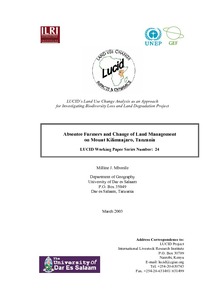Irrigation deficits and farmers’ vulnerability in Southern India
Land ownership does not prevent vulnerability in less developed countries' agriculture and it is demonstrated that land assets do not necessarily imply livelihoods security in areas where irrigation water is scarce and in irregular supply. To capture both the vulnerability and risks that farmers are involuntarily taking in farming, irrigation deficits applied in cash crops cultivation in an irrigation system in the south of India are calculated.
Factors influencing the utilization of cattle and chicken manure for soil fertility management by emergent farmers in the moist Midlands of KwaZulu-Natal Province, South Africa
The study established the factors that influence the use of cattle and chicken manure for managing soil fertility by surveying a random sample of 224 farm households in the Midlands of KwaZulu-Natal province, South Africa. The majority (87%) of the respondents are farming on communal land with an average farm size of 2.9 ha. Sixty-three% of the farmers in the sample used manure to manage soil fertility in their fields. Despite the fact that chicken manure was available in large quanties in the area, 54% of manure used was from cattle while chicken manure was used by 39% of the sample.
Factors contributing to the marginalization of shifting cultivation in north-east India: micro-scale issues
Shifting cultivation, locally known as jhum, is the predominant agricultural practice for most communities inhabiting the uplands of north-east India. The negative impacts of the practice on forest and biological resources, soil erosion and land degradation have been a serious concern for several decades now to administrators and planners as well as to the academic community. In the current context, the practice has undergone drastic changes and has become increasingly unviable, gradually leading to the marginalization of farmers practising it.
Assessing farmers' willingness to participate in water banking: a case study
investigation of the physical and socioeconomic determinants of soil erosion in the Hararghe Highlands, eastern Ethiopia
The vicious poverty–environmental spiral commonly exists due to the interconnectedness of the socioeconomic aspects of farmers and land degradation. The socioeconomic situation of farmers affects their capabilities to implement environmentally viable soil and water conservation measures. These situations include farm practices and attitudes toward rational use of resources. An observational study was conducted to have an insight of the perception of farmers about the danger of gully erosion and their willingness to adopt new improved soil and water conservation measures.
Implications of land and water degradation for food security, with particular reference to Asia and Africa
Absentee farmers and change of land management on Mount Kilimanjaro in Tanzania
ILRI annual report 2002. Better lives through livestock - research serving the millennium goals
This publication provides sharper focus on reducing poverty where it is most absolute and most wide spread. This review outlines a new strategic goal, collaborative ways in which the institute is enhancing its responsiveness to the fast - changing global environment; and five new research themes, viz, Targeting opportunities, Enabling Innovations, Market opportunities, Biotechnology and people, and Livestock and the Environment. The review also identifies three broad pathways, viz security assets, improving productivity, and accessing markets.
A Rich Man’s Hobby
Argues that the price of commercial farmland in Namibia is high in relation to the profits that can be made from commercial livestock farming. As a result, farming is rapidly becoming the preserve of the urban rich who farm as a lifestyle choice and are prepared to subsidise their farms from their principal sources of income. Government policy is trying to encourage black Namibians into commercial farming through the Affirmative Action Loans scheme. However, given the price of land, many of these farmers will struggle to create commercially viable farms.
FONTIERRAS : structural adjustment and access to land in Guatemala; a study proposal, external evaluation report
Understanding Farmers: Explaining Soil and Water Conservation in Konso, Wolaita and Wello, Ethiopia
Soil erosion by water is an old problem in Ethiopia. The prevalence of mountainous and undulating landscapes, coupled with the expansion of arable farming on steep areas due to population pressure have aggravated the soil erosion problem in the country. Prompted by one of the great famines in the country in 1973, the international community and the Ethiopian government began to carry out massive conservation measures that covered extensive areas. Since then, the conservation movement has continued.






